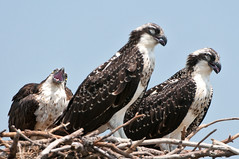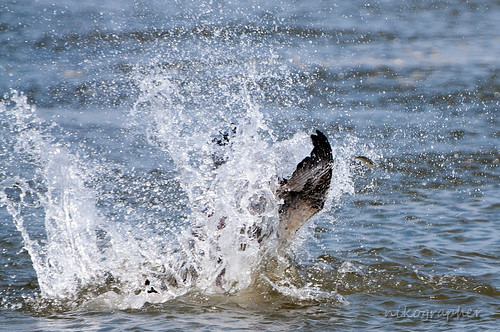From - http://natureandwildlifephotography.blogspot.com/
I think to be a successful nature/wildlife photographer you have to be judgmental! What do I mean by that? Well here goes...
To make animal photos that are more than snapshots, more than an "oh look, click!" type of photo it takes skill in observation. It takes time to see and think like the subject. To make predictions and try to either put yourself in the right spot at the right time or to let something play out the way you would like.
In my recent shooting of the osprey nest here in Maryland I've noticed a few things, and tried a few things, and had pretty good luck.
read more...
The first time I visited this nest, was a couple or more months ago when the female was on eggs, so no chicks yet. What I noticed was the nest was super close to land. Having seen a nest or two that was too close for the bird's comfort I was excited and a bit cautious. I decided to wait to come back. And by the time I came back again 2 of the 3 chicks were fledged.
When I got there a walked up near the nest, and got the usual yips from the chicks and more from the mom. After a minute she calmed down, and I also backed off a bit. After that and a little time it almost became hard to get a reaction from them. I didn't want to them to fly off the nest or anything, it was just odd that they didn't care so much, even if I was pretty close.
It was then that I knew they were used to people being in the area and while aware of it all, they could deal with it well. Later visits I'd get close, back off, other people would come by or a boat or a plane and the additional activity might make them fly.
Judging the circumstances and their behavior - on more than one occasion I backed away from the nest and sat down, or generally looked away did my thing to let them watch and come back to the nest, and not be bothered by my presence. This tactic worked.
If you've watch an osprey nest you are probably aware that the adults are big and can take care of themselves well, be it a crow or an eagle, or another osprey that is a threat. But they can also be skittish and fly away from the nest if bothered or not come back if a person is too close.
I've watched that series "In to the lions den" and I think a lot can be learned from it. The guys approach is to be super observant and to build awareness of animal behavior. Then to take that knowledge and try to build trust with the animals so you can come to a common ground where you just are there, and they don't get bothered by his presence. In the show he used this technique to go from roaring lions at 150 yards, to laying down on the ground unprotected at around 15 feet from the pride!
While I'm not him, and these aren't lions, observing osprey and trying to make all kinds of judgments as to their thoughts and your actions has led to some great chances at photographs.
This particular location is odd and great in that the birds are close and NOT bothered by people that much. They've become habituated to people being in the area. And the calmness of the adults has carried over to the chicks. This weekend the 3rd chick fledged (or had just done so the day before). Using past experience I'd say that birds which aren't comfortable - that can fly away - will fly away if bothered. This weekend the birds didn't fly away due to me being there at all I think. I even got as close as the shore would allow, and got the occasional stare but not much else.
Then came the male. I hadn't seen him all that much. In the week or so of observation I'd been wanting to see all 5 birds (2 adults and 3 chicks). When the male visited late in the day, he flew by and buzzed the nest and fly off. Having seen this same skittishness in the male from a different nest I watched last year, I backed off and waited and within a few minutes he came back and delivered a fish.
Last year when I saw this skittishness I tried to avoid taking shots after that first fly by on the nest. Holding off worked sometimes but he was still skittish. And this testing it out on my part was difficult at times because I wasn't the only photographer there. The other guys did try it too and it seemed to help but the birds were uneasy and with multiple people it is a hard thing to control and gain insight from. Imagine if that Lion guy was trying to get to be friends with a lion pride and was doing it while part of a group of 3 people!?@
This weekend when the male flew by I took the initial shots of him flying, backed off/away and he came back. Then he went and caught more fish and I repeated the same thing but moved off quicker and he came back quicker too. 
The point of this is to be observant, be in the moment, watch for signs of discomfort in subjects and possible causes which you might control - like movement, distance from subject, noise you're making, etc. Animals will give signs of their comfort or lack there of, and often will do it before they are ready to fly away.
Watching nests can be pretty easy as a photographer, and pretty stressful on the birds if you get too close or don't watch for the signs and respond to them. It is a common things for birds to abandon eggs or even young chicks if they're bothered. When approached properly though getting to see the variety of behavior and interactions between adults and offspring can be very rewarding.
--
As a photographer I like to be thoughtful and question my own actions. I also like to watch others and then wonder to myself if I'd do it the same way or differently given the chance. To get close and get close photos takes more than a long lens. It takes time to observe and learn, and time to experiment and to try again and again.
This spring I spent more than a couple days hunting around for the new perfect spot to try to shoot osprey. I had two in mind and my fall back spot turned in to the better one. In a couple evenings and a couple afternoons I shot around 60GBs of stuff (osprey and a couple green herons). I'm going to try to go back and get more of the adults and especially the chicks fishing. I've seen 1 or 2 of the chicks hunting and been surprised how clumsy they are, but how well they do too.
Make plans! Summer will be wrapping up before you know it and Fall migration will be upon us. What will you do to see better things, take better photos and make this Fall your best? I'm going to visit some new spots, as well as some spots that were new to me last year. ![]()
Tuesday, July 20, 2010
Observe and be Judgmental
Original content posted at http://natureandwildlifephotography.blogspot.com/
Nikographer.com / Jon
Labels:
birds,
Judgmental,
Maryland,
MD Osprey,
Nature,
Observation,
Wildlife
Subscribe to:
Post Comments (Atom)








4 comments:
Well written. That's what I pride myself on, as I don't physically have a long lens...so I literally have to rely on my ability to read my subject and try the best I can with that.
You mentioned Into the Lions Den...I think that's Dave Salmoni? I love him...he very much is a 'sense your subject' kinda guy, which plays perfectly into your point. During my 'gator-days' judging my subjects was the most important aspect (editor of Nature's Best Photo Mag. actually had me write an article on that point last year!) cause things can turn bad in a heartbeat if you misread your subject.
Anyways, although birds tend not to attack humans, it's important in a photography way to judge their behavior and what you can get away with. Will make for better photos and a deeper connection to your subject.
Great points!!!!! Nice job
p.s. your multiple photographer point is so true. I hate when that happens and it's impossible to truly get in-touch with your subjects when others are there too!
Yeah that's the guy, Dave Salmoni.
We've talked about how being a hunter makes you a good photographer. Being aware and observant and focused really helps in both hunting and photography.
I've got a series of Green Heron photos to post that tie in to this topic too. He was practically inside my lens. And initially he flew away when he saw me, because I was so tall and cast such a shadow, etc. Once I laid down, it was easy as pie (the next time I spotted him).
So - this post was about location helping, subjects helping, and then how much other stuff can be controlled or steered to make things work out better. A clumsy hunter might get lucky, but not often. Right? Or maybe it's that saying - luck favors the prepared.
terrific post, Jon! reading a subject is such an important part of wildlife photography, and if you take it slow and let the animal dictate the pace of the encounter, I'm often surprised at how willing they are to let you into their world.
Post a Comment